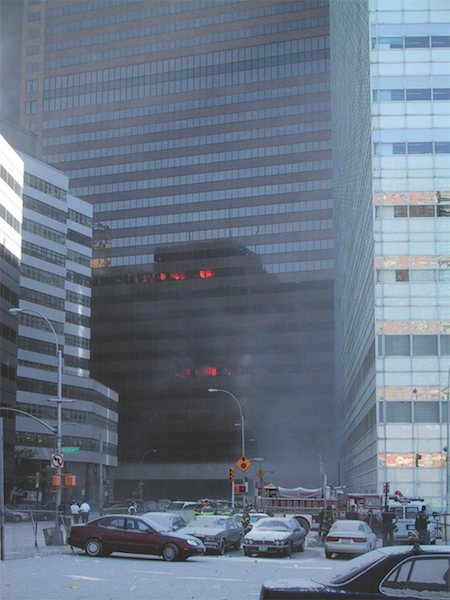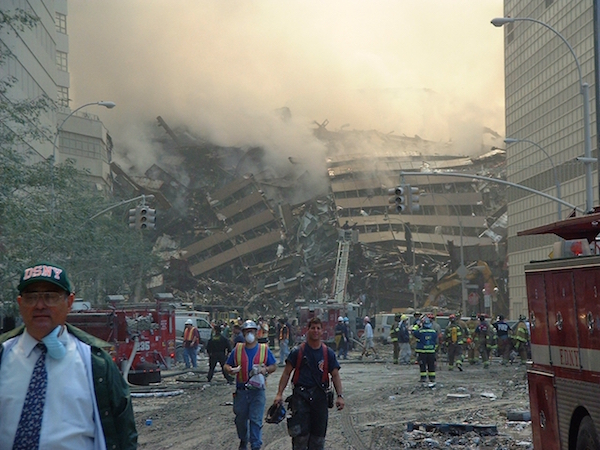About an hour after the destruction of WTC 1 at 10:28 AM, the authorities at the World Trade Center began anticipating the collapse of WTC 7 with a high degree of confidence and precision. Their anticipation was so strong that the media widely reported on WTC 7’s imminent collapse, with some news outlets even reporting the collapse before it occurred.
A selection of the accounts illustrating this widespread anticipation is presented in Appendix B of Beyond Misinformation: What Science Says About the Destruction of World Trade Center Buildings 1, 2, and 7.
The official hypothesis would have us believe that the authorities’ anticipation was “evidence-based,” a prediction made on the basis of assessing the damage and fires in WTC 7. However, when examined closely, the high degree of confidence and precision suggests that it was instead knowledge-based. In other words, someone at the scene had foreknowledge that WTC 7 was going to be brought down and began warning others in order to avoid casualties and to create the cover story of a fire-induced failure. Thus, the warnings were couched as an evidence-based prediction that the building would collapse due to structural damage and fire.
The view that the anticipation was knowledge-based rather than evidence-based is strongly supported by the following facts:
- NIST’s “Probable Collapse Sequence” for WTC 7 consists of an unprecedented and undetectable series of structural failures that could not be predicted on the basis of observing structural damage (which NIST later claimed did not contribute to the collapse) and fires. If we assume NIST’s hypothesis to be true, there would be no reason to anticipate a total collapse, even within the seconds before it occurred. Based on NIST’s scenario, the event that the authorities predicted had an infinitesimal probability of occurring until just seconds before it did. At that point, an extremely improbable chain of events unfolded and made their prediction correct. Such a scenario is not plausible.


- A number of buildings in the vicinity were on fire and sustained much greater damage from the destruction of WTC 1 and WTC 2. Yet authorities seized on WTC 7 as the one building that was certain to go down and established a safety zone around it.
- The FEMA Building Performance Study concluded that the best hypothesis it could come up with had “only a low probability of occurrence.” 1 How were the authorities able to predict such a low-probability event?
- Engineers were “stunned by what happened to 7 World Trade Center” and unable to explain it.2 Even as late as March 2006, NIST’s lead investigator told New York Magazine, “I don’t really know. We’ve had trouble getting a handle on building No. 7.” 3 How were the authorities able to predict an event that engineers would be unable to explain even four and half years later?
- A CNN video captured both the sound of an explosion coming from WTC 7 and an emergency worker’s warning that WTC 7 was “about to blow up” just seconds before its destruction:
[Sound of explosion]. Unidentified voice: “You hear that?” Voice of emergency worker #1: “Keep your eye on that building, it’ll be coming down....” Voice of emergency worker #2: “Building is about to blow up, move it back.... Here we are looking back, there’s a building about to blow up. Flame and debris coming down.” 4
- There are at least four accounts showing that a controlled demolition was being considered or planned (see David Restuccio, Indira Singh, Jeffrey Shapiro, and Larry Silverstein in Appendix B of Beyond Misinformation: What Science Says About the Destruction of World Trade Center Buildings 1, 2, and 7).
Endnotes
[1] FEMA: World Trade Center Building Performance Study: Data Collection, Preliminary Observations, and Recommendations (May 2002), Chapter 5, p. 5-31.
[2] Glanz, James: “Engineers Have a Culprit in the Strange Collapse of 7 World Trade Center: Diesel Fuel,” The New York Times (November 29, 2001).
[3] Jacobson, Mark: “The Ground Zero Grassy Knoll,” New York Magazine (March 2006).


